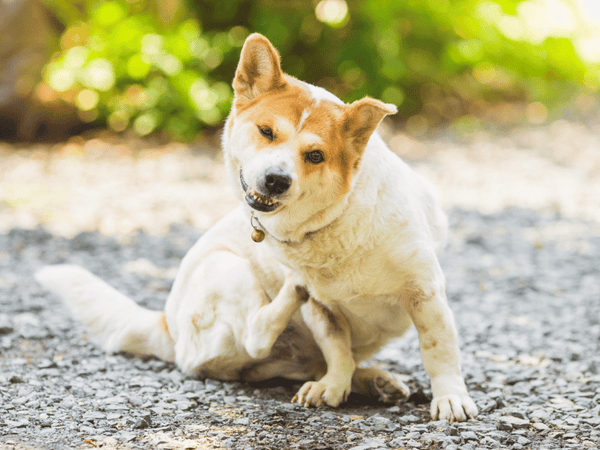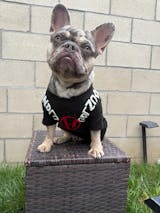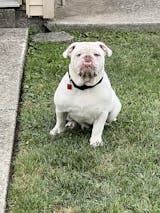Seasonal Allergies in Dogs: Symptoms and How to Help
Just like humans, dogs can suffer from seasonal allergies leading to discomfort and distress. As the seasons change, so do the environmental allergens that can affect our furry friends. Understanding the types of allergies dogs face and recognizing the symptoms can help you provide the necessary care and relief to your doggo. In this post, we’ll explore the various types of seasonal allergies dogs may encounter, the common symptoms to watch out for, and helpful tips to alleviate their discomfort.

Types of Seasonal Allergies:
Dogs are more likely to face seasonal allergies during periods of heightened allergen exposure, typically coinciding with changes in the environment, such as springtime blooming of flowers and trees or the increase in humidity during warmer months. Let’s dive into the various types of seasonal allergies that can often affect our furry friends during this time.
- House Dust Mites: These microscopic creatures can trigger allergic reactions in sensitive dogs, especially in environments with poor ventilation or excessive dust buildup.
- Grass Pollen: As grasses start to bloom, dogs may inhale pollen, leading to allergic reactions.
- Weed Pollen: Common weeds like ragweed can release pollen into the air, causing allergic symptoms in dogs sensitive to these allergens.
- Tree Pollen (Oak, Cedar, Ash): Trees are a significant source of pollen during the spring season, and sensitive pups may react to specific tree species.
- Yeast: Yeast can be found in various environments and can trigger allergic reactions in dogs, particularly in warm and humid conditions.
- Mold and Mildew: Damp environments provide ideal conditions for mold and mildew growth, which can worsen allergies in dogs.
- Fleas: While not strictly seasonal, flea allergies can worsen during warmer months when flea populations thrive.
Symptoms of Seasonal Allergies in Dogs
Have you noticed your pup acting a little strange when the seasons are changing and the trees are starting to bloom? Well, this may be a result of seasonal allergies. Let’s take a look at the various symptoms to look for to ensure you can take precautions in caring for your furry friend moving forward!
- Excessive Licking: Dogs may excessively lick their paws or other parts of their body as a response to itching and discomfort caused by allergies.
- Chewing/Gnawing/Scratching: Persistent scratching or chewing at the skin is a common symptom of allergic reactions in dogs to alleviate their discomfort.
- Redness on the Skin: Allergic reactions can cause inflammation and redness on the skin, particularly in areas that come into contact with allergens.
- Watery Eyes: Dogs with seasonal allergies may experience watery or teary eyes as a result of exposure to allergens.
- Crusts and Moist Skin: Allergic dermatitis can lead to the formation of crusts or scabs on the skin, accompanied by moist or oozing patches.
- Odor on the Skin and Ears: Yeast overgrowth due to allergies can cause a distinct odor on the skin and ears of affected dogs.
- Head Shaking: Dogs may shake their heads frequently as a response to ear irritation caused by allergies.
- Reverse Sneezing: This rapid, noisy inhalation is a common symptom of allergic reactions in dogs and can be alarming for pet owners. To stop reverse sneezing in dogs, gently massage their throat or offer them a sip of water to help alleviate the spasms. Additionally, calmly reassuring your dog and keeping them calm can help to reduce the frequency and severity of reverse sneezing episodes.
How to Help Your Pup
- Identify and Minimize Exposure to Allergens: Try to identify and minimize your dog’s exposure to specific allergens, such as keeping them indoors during peak pollen times or using air purifiers to reduce indoor allergens.
- Regular Grooming: Regular grooming can help remove pollen and other allergens from your dog’s coat, reducing the risk of allergic reactions. Use Squishface Wrinkle Wipes to clean your pup after an outdoor adventure, to help keep them free of dirt, debris, and allergens that may be affecting your pup.
- Don’t Forget Slobber Control: For drooly breeds or pups who tend to get messy after eating or drinking, Squishface Slobber Towels are a must-have during allergy season. Moisture around the mouth, face, and skin folds can trap allergens and promote yeast or bacterial growth—leading to more licking, scratching, and irritation. These ultra-absorbent towels are perfect for wiping down your dog after meals, drinks, or outdoor time, helping to keep their skin dry and clean. They’re also great for protecting your furniture, car, or your lap during cuddle time!
- Topical Treatments: Squishface Wrinkle Paste can help soothe and protect your dog's itchy, irritated skin and paws. Apply directly to the skin after wiping the area with Wrinkle Wipes. Don't forget the baby socks if you apply it to the paws unless you want little paw-prints on your floor.
- Allergy-Friendly Diet: Some dogs may benefit from an allergy-friendly diet that helps support their immune system and reduces the risk of external allergic reactions.
- Medication and Supplements: Your veterinarian may prescribe medication or supplements to help alleviate your dog’s allergic symptoms, such as antihistamines or omega-3 fatty acids.
- Flea Prevention: Implement a comprehensive flea prevention program to reduce the risk of flea allergies and infestations.
- Prioritize Ear Care: Squishface Ear Wipes are an excellent solution for maintaining your dog's ear health and cleanliness on a daily basis, particularly for dogs prone to ear allergies and infections. Infused with soothing ingredients, these wipes help alleviate irritation and remove excess wax and debris, reducing the risk of allergic reactions.
The Bottom Line:
Prioritizing your dog's health and well-being during allergy season is essential for their comfort and happiness. By implementing these dog care tips and remaining vigilant for signs of seasonal allergies, you can help alleviate your furry friend's discomfort and ensure they enjoy the changing seasons to the fullest. Remember, regular grooming, a healthy diet, and frequent monitoring of your pup are crucial components of effective dog care both during allergy season and throughout the year. Don't forget to include Squishface Wrinkle Wipes for wipe-downs after outdoor adventures and Squishface Ear Wipes for maintaining clean, healthy ears. With a little extra care and attention, you can ensure your dog stays happy, healthy, and allergy-free year-round.
Be sure to follow us on TikTok, Instagram, Facebook, Pinterest, YouTube, and visit our blog weekly for more tips on caring for your adorable doggo, and the latest on all things Squishface!










